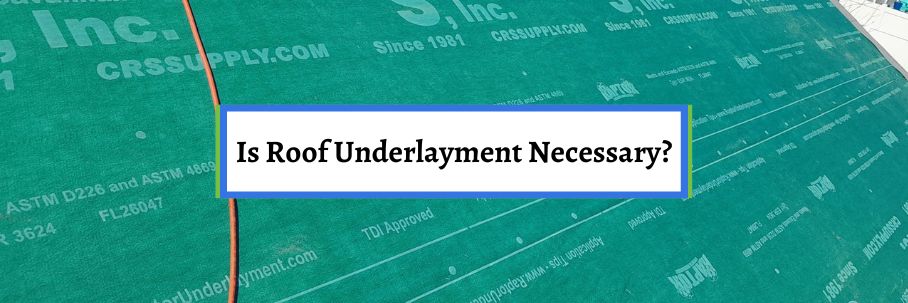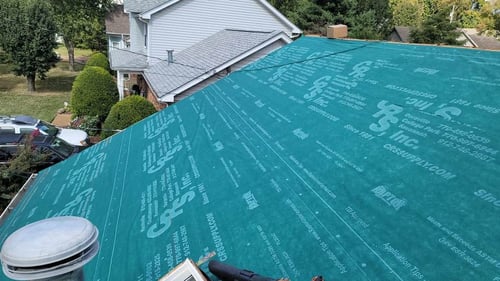Is Roof Underlayment Necessary?

A roof is more than just the shingles you see from the street. There’s more under the hood that provides extra layers of protection and keeps your home leak-free.
While each component and material protects your home, roof underlayment is one of the last lines of defense. Unfortunately, there’s misinformation out there that makes it seem less important than it actually is.
This has led some homeowners to ask, “Is roof underlayment even necessary?”
For over 30 years, the team at Bill Ragan Roofing has helped homeowners understand all aspects of their upcoming roof investment. Because of this, I’ll break down what you need to know about roof underlayment and if your roof really needs it.
This article answers the following questions:
- What is roof underlayment?
- Is roof underlayment necessary?
- How do you choose the right type of roof underlayment?
What is roof underlayment?
Roof underlayment is installed directly over your roof decking to provide an extra layer of protection from the elements. The whole purpose of roof underlayment is to protect your decking if water ever gets underneath your roofing material.
There are two common types of roof underlayment: felt and synthetic.
Felt roof underlayment is, like the name says, made of a felt material that comes in 15 lb or 30 lb rolls. The big differences between the two types of felt underlayment are that 30 lb is thicker, stronger, and less likely to tear than 15 lb.
 (Synthetic roof underlayment)
(Synthetic roof underlayment)
Synthetic underlayment has been around the roofing industry for about 20 years and was developed as technology improved. It’s made of woven/spun polyethylene or polypropylene that wicks off water if it gets wet.
Both type of roof underlayment are great options, but you need to pick the right one for you. In a minute, I’ll help you do just that.
Is roof underlayment necessary?
Now that you know what roof underlayment is, you’re ready to learn if it’s necessary. Yes, roof underlayment is a necessary roofing component that every roof should have.
Remember, roof underlayment protects your decking if water ever gets underneath your roofing material. Without underlayment, this water eventually rots your roof decking leading to leaks, mold/mildew forming, and even structural damage.
.jpg?width=500&height=391&name=DeckingRotten%20(2).jpg) (Rotten roof decking)
(Rotten roof decking)
Can you install a roof without underlayment? Of course, you can. However, a reputable roofing contractor will never recommend skipping underlayment.
No matter what you read or hear, you should never trust a roofer who says your roof doesn’t need underlayment. If you do, you’re not getting the protection your roof and home need.
How do you choose the right type of roof underlayment?
Now you know roof underlayment is absolutely necessary for every roof. But with it being necessary, you need to be sure you choose the right type.
The best way to determine which type of roof underlayment is by considering a few things. Let’s figure out if felt or synthetic underlayment is right for you.
Which type of roof underlayment weighs more?
The first thing you need to consider is which underlayment weighs more. You may not think this is important, but the weight impacts the labor cost of your roof replacement.
No matter if it’s 15 or 30-lb rolls, felt roof underlayment weighs more than synthetic underlayment. Because it’s heavier, felt underlayment doesn’t have as much material per roll as synthetic roof underlayment.
This leads to needing more rolls of material during installation, which takes more time and manpower to get it up the ladder. Just know that this won’t add a lot to the overall labor cost of your roof replacement.
However, you still need to keep it in mind when choosing your roof underlayment.
Which type of roof underlayment is more durable?
The next thing you need to consider is durability. Both types of roof underlayment provide an extra layer of protection, but synthetic underlayment is more durable than felt underlayment.
Felt underlayment is prone to rip in the event of high winds, and the felt material absorbs water if it gets wet. Because of this, shingles must be installed as soon as felt underlayment is laid down over the decking to avoid any tears in the material.
On the other hand, synthetic underlayment repels water and holds roofing nails better than felt underlayment. Synthetic underlayment is made to be non-skid, so also you don’t have to worry about tearing or crew members slipping as they finish your roof.
This makes it safer for everyone to work when installing the rest of your roofing components and materials over the top of your underlayment.
Which type of roof underlayment costs more?
The next thing to consider is which roof underlayment costs more. Like everything else, this is the biggest concern for most homeowners.
Your roof underlayment is wrapped into the total cost per square of your new roof, but there is a difference in their price points. Just know that I can’t give you exact pricing because of the constant fluctuation of material prices in the roofing industry.
With that in mind, synthetic roof underlayment is more expensive than felt roof underlayment. However, the cost difference between the two isn’t honestly that far apart.
Roof underlayment doesn’t necessarily have a huge impact on the overall cost of your new roof. However, considering your budget is still important when deciding which type of roof underlayment is right for you.
What other components and materials does your roof need?
Now you should have a good idea of which type of roof underlayment is right for you. I recommend spending just a little more to get synthetic underlayment for increased durability.
However, it’s completely up to you and your budget to determine which one is right for your roof replacement. And most importantly, remember that roof underlayment is necessary when getting a roof replacement.
But roof underlayment is just one piece of a larger puzzle that makes up a roof system. That’s why you need to know the rest of the components your roof needs.
Not only does this help you understand your upcoming roof investment better, but it also helps you avoid being taken advantage of by a roofer who leaves things off their estimate to lower their price.
That’s why I wrote another article that breaks down the rest of the materials and components that must be included in your roof replacement estimate.
Check out 9 Materials Included With Your Roof Replacement to learn every material and component that must be replaced when getting a new roof.


